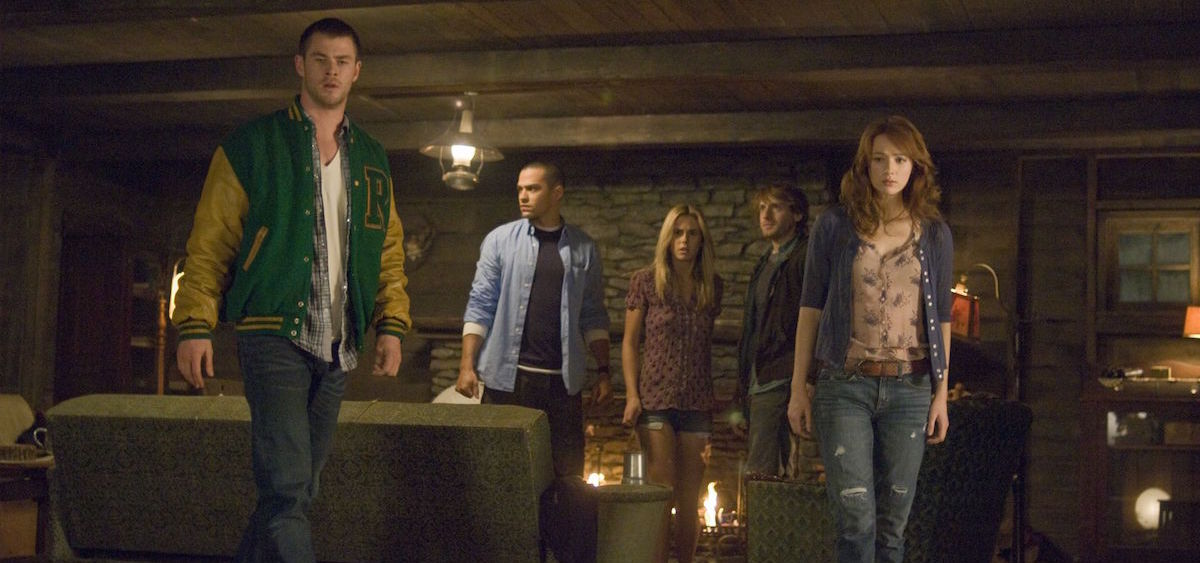Culture

Movie Review: “The Cabin in the Woods”
By: Scott Pfeiffer
Posted on:
Part of the fun of this horror/comedy picture (and I debated which genre to place on the weightier side of that slash) is not so much discovering its “secret” as it is teasing out the levels on which it’s about the whole idea of watching.
At first we have what seem to be two unrelated storylines. We open on an everyday, mundane water-cooler chat between two middle-aged office workers (Bradley Whitford and the great Richard Jenkins). Cut to a group of stock horror movie teenagers–the athlete, the fool, the scholar, the “virgin,” the “whore”–gearing up for a stock horror movie situation: a few fun days in…well, a cabin in the woods.
Is the cabin out in the middle of nowhere? You bet it is. Do they meet a poxy old guy on the way up who leaves the air fetid with foreboding? Of course they do.
The in-your-face titles fill the screen startlingly, interrupting a scene Funny Games-style. It’s a nod that tips you off to what the movie is going to try to do: rib the audience for its bloodlust and enact the bloody ritual at the same time.
And it is a ritual to go to a horror movie. That’s the point. While this movie cannot be as shattering as the Michael Haneke picture, the fact that it will actually be seen by the target audience makes its critique perhaps even more subversive.
Once at the cabin, the kids must of course explore the basement. It’s all part of the ritual, you know. They find a jumble of Pandora’s boxes: a sinister Rubik’s cube-like puzzle, spooky porcelain dolls, a murdered mountain girl’s dusty journal, etc.
I will leave you to discover the connection between that opening scene and what develops, but let’s just say it involves puppet masters, and none more so than the guys behind the camera, writer Joss Whedon and director Drew Goddard.
Whedon and Goddard have been craftily playing with genre elements ever since their days on Buffy The Vampire Slayer, a show that’ll always have a special place in my heart. The puppet-master metaphor actually suits Whedon’s dialogue, which, if it has a weakness, it’s that it sometimes feels like it’s emanating not from the mouths of individuals so much as it’s been placed their by the puppet-master, Whedon.
That said, the script is as quick and quippy as you’d expect. What you won’t be expecting are the nasty jolts. There’s an interesting sphere where Whedon’s and Quentin Tarantino’s concerns overlap, but the gore here crosses over into the grindhouse territory we associate with Tarantino or his friend Eli Roth.
Whedon and Goddard let the metaphors (and the meta fun) fly. There is a surprise star turn by a famous actress playing a “Director” (nudge, nudge). And the movie ends with a bravura, hilarious sequence–which would be a crime to spoil–but let’s just say they bet big on the basic premise that they can make us laugh and jump at the same time, and they cash it all in. They do miss a trick or two along the way: the kids find a two-way mirror, which would make a nifty metaphor for the movie screen if anything was ever done with it, which it isn’t.
In The Cabin In the Woods, the teenage blood being spilled is for us, the horror movie audience. We’re the hungry gods who must be appeased.
We haven’t forgotten those days of sleepovers, when sitting on the floor watching R-rated horror and eating pizza seemed to be about as good as life got. Neither have the people who made this movie.
Born in Athens, Ohio, Scott Pfeiffer has lived in Chicago since 1993. He did a minor in film at Ohio University back in the day. These days, he knocks about Chi-town, taking in film, music and theater. Read his other music and film reviews at The Moving World.

